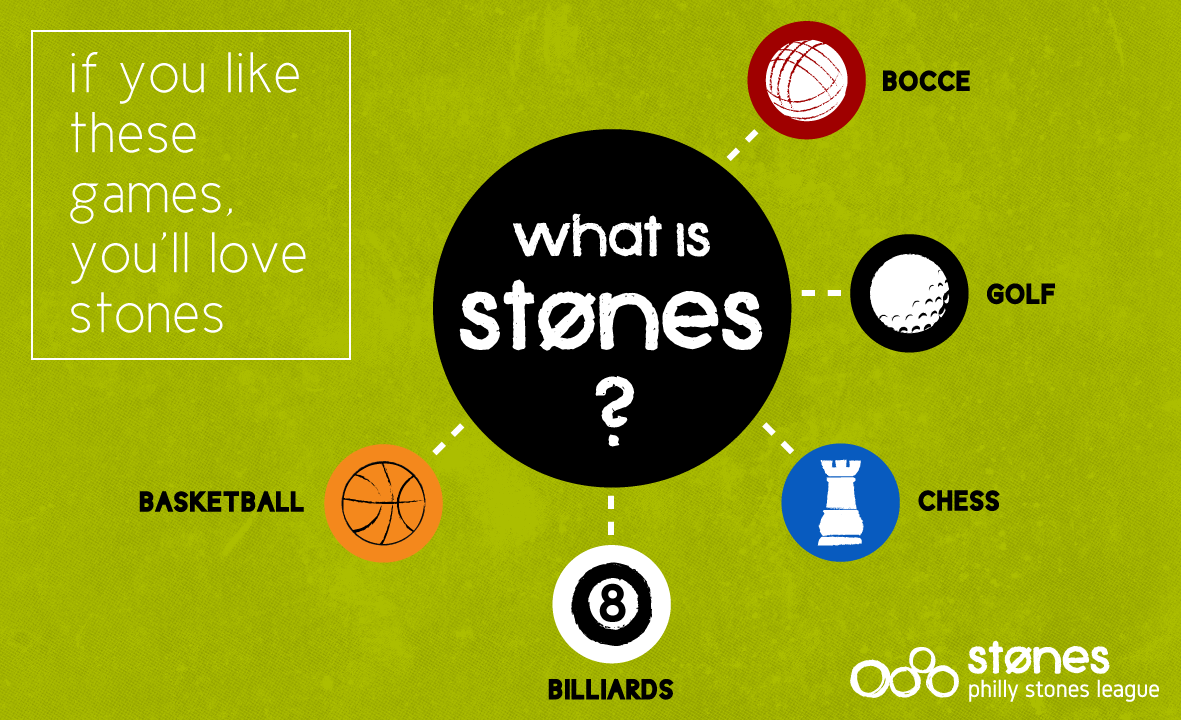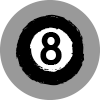
STONES is a ball toss game played through a defined course with obstacles and boundaries. Teams throw their stones at a target ball with the closest ones scoring points. With each round, the target ball advances on the course, and when the end of the course is reached, the team with the most points wins.
While you might not have played the game of Stones, odds are that you’ve experienced elements of it through other games you’re familiar with. It combines elements of bocce, golf, chess, billiards, and basketball to make up the physical, psychological, and intellectual aspects of Stones.
 Let’s start with the most obvious game that Stones emulates: bocce. Stones follows the basic gameplay of bocce in which players from two teams take turns throwing their stones with the goal of having theirs rest closest to a smaller target ball. Points awarded for each stone a team has thrown closer than their opponent’s closest stone. As players advance through the course, each round begins where the last round ended, and the basic objective remains the same. While bocce is played on a flat surface, a Stones course is a bit more complex.
Let’s start with the most obvious game that Stones emulates: bocce. Stones follows the basic gameplay of bocce in which players from two teams take turns throwing their stones with the goal of having theirs rest closest to a smaller target ball. Points awarded for each stone a team has thrown closer than their opponent’s closest stone. As players advance through the course, each round begins where the last round ended, and the basic objective remains the same. While bocce is played on a flat surface, a Stones course is a bit more complex.
 There are the aspects of Stones that mimic golf as well. As players advance through the course with each successive round, they move through a space with clearly marked boundaries, obstacles, water hazards, shifts in topography, and surfaces of varied textures. It’s no miniature golf course, in the traditional sense, but it most definitely resembles a golf course, on a miniature scale, with all of its intricacies and nuances that directly impact play. Beyond the similarities of each game’s playing fields, the equipment used to throw stones does as well. Each player has 4 stones in his/her bag during a game. There is the small 90mm, two mediums of 100mm, and the large 110mm. During each round, only 2 of the 4 are thrown by each player. Much like golf’s club selection, stones are chosen on a situational basis. A wide variety of factors go into stone selection for each throw, and these choices can make the difference between winning and losing.
There are the aspects of Stones that mimic golf as well. As players advance through the course with each successive round, they move through a space with clearly marked boundaries, obstacles, water hazards, shifts in topography, and surfaces of varied textures. It’s no miniature golf course, in the traditional sense, but it most definitely resembles a golf course, on a miniature scale, with all of its intricacies and nuances that directly impact play. Beyond the similarities of each game’s playing fields, the equipment used to throw stones does as well. Each player has 4 stones in his/her bag during a game. There is the small 90mm, two mediums of 100mm, and the large 110mm. During each round, only 2 of the 4 are thrown by each player. Much like golf’s club selection, stones are chosen on a situational basis. A wide variety of factors go into stone selection for each throw, and these choices can make the difference between winning and losing.
 The game of chess is primarily about always plotting a few moves ahead, attempting to lure your opponent into situations that cost them pieces and will eventually lead to checkmate. For the most skilled stones throwers, the same can be said for how they approach each and every round of Stones. As each stone in a given round is thrown, players are looking for ways to lure their opponent into situations that will cost them stones, limiting the opponent’s chance of winning the round and increasing their own odds of scoring multiple points. It’s about anticipating each throw of one’s opponent, and strategically attempting to take full advantage of it.
The game of chess is primarily about always plotting a few moves ahead, attempting to lure your opponent into situations that cost them pieces and will eventually lead to checkmate. For the most skilled stones throwers, the same can be said for how they approach each and every round of Stones. As each stone in a given round is thrown, players are looking for ways to lure their opponent into situations that will cost them stones, limiting the opponent’s chance of winning the round and increasing their own odds of scoring multiple points. It’s about anticipating each throw of one’s opponent, and strategically attempting to take full advantage of it.
 Billiards is a game of basic physics. The object is to hit the cue ball into another ball on the pool table with just the right amount of force and spin, striking the ball of choice at the proper angle. The basic intent here is to send the ball that is struck into a pocket on the table AND to have the cue ball come to rest at a predetermined spot, setting up one’s next shot. Because rounds of Stones are played at varying distances, on shorter throws it becomes much like a game of billiards. Speed, spin, and angle are mulled over with each throw, attempting to set one’s stones in a way that will both maximize points and limit opponent’s chances.
Billiards is a game of basic physics. The object is to hit the cue ball into another ball on the pool table with just the right amount of force and spin, striking the ball of choice at the proper angle. The basic intent here is to send the ball that is struck into a pocket on the table AND to have the cue ball come to rest at a predetermined spot, setting up one’s next shot. Because rounds of Stones are played at varying distances, on shorter throws it becomes much like a game of billiards. Speed, spin, and angle are mulled over with each throw, attempting to set one’s stones in a way that will both maximize points and limit opponent’s chances.
 A good stones thrower is like a good shooter in basketball. A confident shooter or thrower uses mental toughness to maintain consistency in pressure situations when the game is on the line. When players lose their focus or confidence in either sport, problems arise, resulting in missed shots or throws one might normally make. Good mechanics and fundamentals are essential, yet overthinking these in a pressure situation could create a choking hazard. Good 3-point shooters might not shoot at a high percentage from mid-range, and while some Stones players might excel at sticking their stones next to the mark in long distance situations, their knockout game may suffer from a few yards away. The similarities aren’t limited to the act of shooting or throwing, either. NBA fans are familiar with some of the players’ unique free throw rituals, such as going around-the-back, shooting a few steps behind the line, or blowing kisses. Watch a few Stones tournaments and you’ll pick up on many trademark routines players have when warming up for a throw.
A good stones thrower is like a good shooter in basketball. A confident shooter or thrower uses mental toughness to maintain consistency in pressure situations when the game is on the line. When players lose their focus or confidence in either sport, problems arise, resulting in missed shots or throws one might normally make. Good mechanics and fundamentals are essential, yet overthinking these in a pressure situation could create a choking hazard. Good 3-point shooters might not shoot at a high percentage from mid-range, and while some Stones players might excel at sticking their stones next to the mark in long distance situations, their knockout game may suffer from a few yards away. The similarities aren’t limited to the act of shooting or throwing, either. NBA fans are familiar with some of the players’ unique free throw rituals, such as going around-the-back, shooting a few steps behind the line, or blowing kisses. Watch a few Stones tournaments and you’ll pick up on many trademark routines players have when warming up for a throw.
Playing Surface
The sky’s the limit here. Stones courses have been developed on beaches of soft sand and crushed shells; within forests covered in pine needles, twigs, and branches; in mowed meadows; and on all soil consistencies. In addition, level surfaces are frowned upon—the more slopes, hills, and jagged cliffs, the better.
Course Obstacles
You name it—it’s been used on a Stones course, as long as it’s not man-made. Here is a short list of what might be in your way: stones, tree trunks, bodies of water, a downed tree, dangling tree branches, root systems, bushes, anthills, and fire. Please let us know if you have ideas yet to be thought of.
Boundaries
There are clearly defined boundaries along the course within play. Stones that rest outside of these boundaries are considered out. Getting your stone close to the mark is half the battle. The other is just keeping them within the field of play.
Stones
Unlike other boules games, Stones is played with balls of different sizes—90mm, 100mm, and 110mm. For each throw, a decision needs to be made. What size is best for the situation? Think golf club selection.
Determining Winners
There is no playing to a set score. Instead, the game is played until the players reach the end of the course, or a finish line if you will.
Strategy
This you will have to figure out for yourself, but follow our YouTube channel for some helpful hints and tips.
